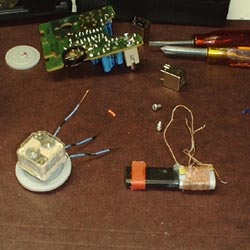

In these modern times it's not easy to find parts. Some of you may be afraid of winding coils (it took me many years to get over helixaphobia). But don't worry there are ways around it. You're going to get the parts from a pocket transistor radio. That's right! I actually went to the local store of a well known national electronics chain and paid about six dollars for one of those little AM radios. I had to buy one because to my surprise I had thrown away the ones I used to have. You only need two parts, the ferrite antenna and the tuning capacitor. Other parts such as the IF transformers and oscillator coil are too delicate to successfully remove from the PC board.

|

|
As you can see from the photo the one I bought is an integrated circuit radio rather than a transistor one. (With care I'm sure I can get the IC off the board in tact, that is after I trace out the circuit. That little package should provide some interesting evenings in the future).Maybe you have some other source of parts. You may have a junker tube radio. If the case is in really bad shape go ahead and junk it out for parts. If it looks good don't tare it apart even if it doesn't work. It's worth money on eBay. So let's say you have a variable capacitor. Good. You don't have to struggle with getting the tuning capacitor off the PC board in tact.
The ferrite antenna is another story though. You can't use the built in antenna from a tube radio. Well, maybe you could but they're offley big and clunky. I have never seen a tube radio that used a ferrite antenna. WELL, NOW I HAVE. The larger transistor portable radios used a much larger ferrite antenna and you can use one of these if you like.
Disassembling the radio.
You have an advantage over a service tech, you don't have to put the radio back together and make it work again. At the same time you don't want to destroy the parts you need. The designer of this one had actually listened to hapless repair technicians and made it easy to get apart. This may not be true in your case especially if you've got an older radio. It used to be common to hide screws under decorative stickers which must be peeled away to get at them. If this is necessary, have no qualms. Break plastic tabs, cut wires, whatever it takes to get the little sucker apart.The wires to the antenna are much too small and flexible to be used to hold the antenna in place. It is usually mounted with plastic brackets. In my case the manufacturer had used some wax to give additional security. Heat the connections where these wires go to the board and gently pull on the wire. Wires in this type of consumer electronics are rarely wrapped around before soldering. The antenna will have 4 wires.
These radios did not use any sort of dial reduction which made them hard to tune. The tuning knob and dial are usually one in the same. Most often there is a small screw at the middle of the knob/dial. Taking out this screw will allow the knob/dial to be removed. There are most likely 2 screws which were hidden by the knob. Do not remove these just yet. Use solder absorbing braid to remove the solder holding the capacitor terminals to the board foils. Remember you are using an absorbent material to wipe up a liquid. It's exactly like using a paper towel except that everything is at a temperature of 700 degrees. And that's the reason some people fail when trying to use this product. To be absorbed the solder has to BE a liquid. The solder wick has to be at a temperature above the melting point of solder. If both conditions are met the solder will be sucked up by the wick like there was a tiny vacuum cleaner in there.
(This product goes under two names that I know of. One is Solder-Wick and the other is Chem-Wick. Have you ever read in a magazine that you could use the braid from a piece of shielded wire or coaxial cable? I have. It was written by somebody who had never tried it but just thought it sounded like it would work. IT WON'T! The kind you buy is coated with a special flux that attracts the molten solder to it.)There are three connections to the tuning capacitor. If at this point you can identify which terminal goes to ground, which goes to the antenna and which goes to the oscillator coil -- the little square can with the red thing visible through the hole in the top -- you will be ahead of the game. Make a sketch on a piece of paper so you won't lose this information. After you have removed the solder you should be able to move the terminal back and forth in the hole. Now remove the screws and the capacitor should fall off into your hand (or to the floor if Murphy has anything to say about it).
Now you have the two parts you need. What you do with the rest of the radio is up to you.
Use your "Back" button to return to where you were.
Thank you for visiting my page at Angelfire.
Please come back and visit again!This site begun March 14, 2001
This page last updated May 9, 2002